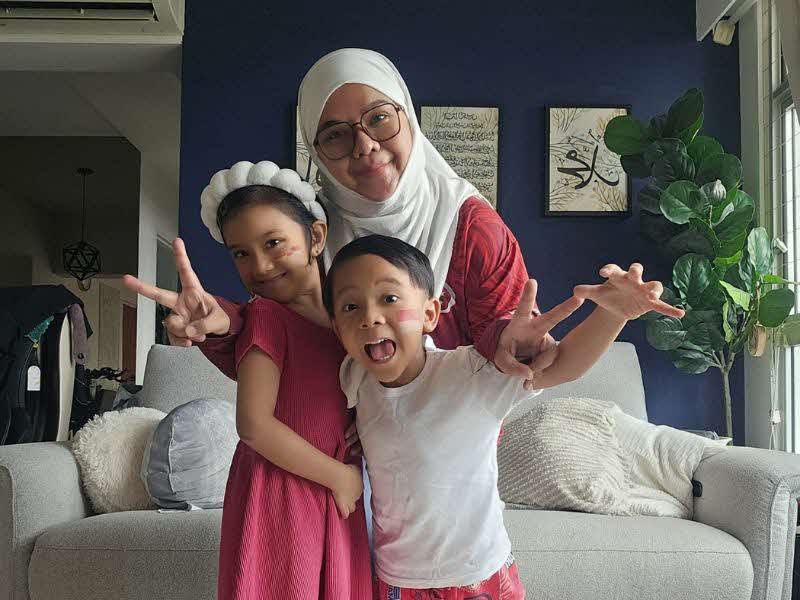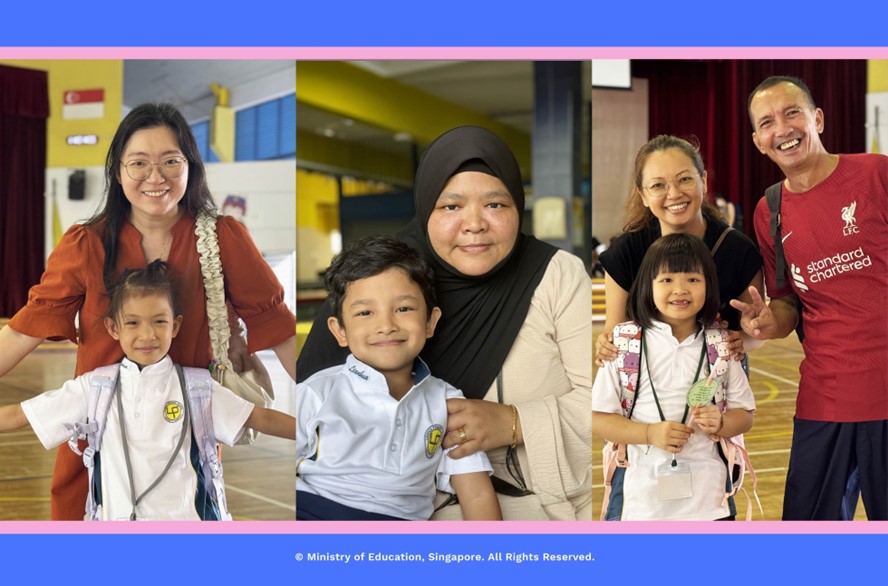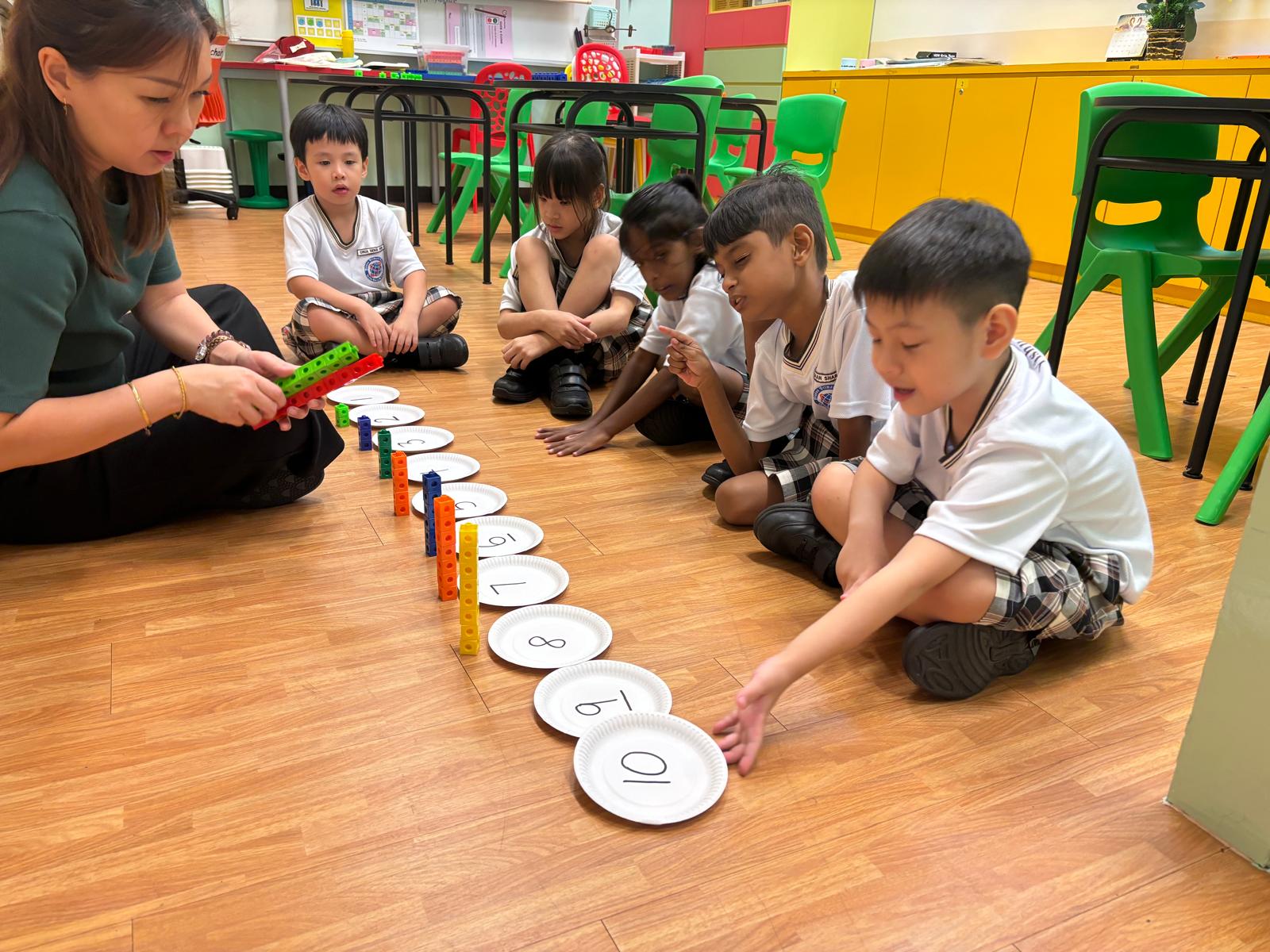Theory, practice, and personal experience – when it comes to preparing children for the transition from preschool to primary school, Mdm Nur Azlina Binte Subari draws from all these perspectives. Not only is she a lead lecturer at the National Institute of Early Childhood Development (NIEC), but she has also navigated this milestone moment with her two children, who are in Primary 1 and 2 respectively.
Schoolbag speaks to Mdm Azlina to find out how to best prepare children for this important step, and why hothousing kids may backfire and stress them out.
Learn to identify each kid’s individual needs
Like all parents, Mdm Azlina wanted to support her children in important learning milestones, such as the preschool-to-primary-school transition. So, a few years before they started primary school, she signed them up for a phonics class to help them improve their reading skills.
“Before enrolling my kids in the class, I tried to engage them in reading activities and games at home,” elaborates Mdm Azlina. “But they often lost focus halfway, so I thought that the more structured environment of a formal class might help supplement my reading activities at home.”
However, she soon realised that the class’s focus on workbook exercises rather than hands-on activities was not a good fit for her children in different ways. “My son made progress in reading, but he often expressed a lack of enjoyment in the class. My daughter questioned why she could not read as well her brother. She said the class was very difficult, and that she was very sad about this.”
Her daughter’s struggles hit her hard. “I didn’t want my child to feel that she was not good enough in comparison to everybody else. As an early childhood practitioner, I understand that children develop at different paces, and I reassured her that she would get there in her own time.” Taking her son’s boredom to heart as well, she pulled both her children out of the phonics class after a year.
The importance of sparking joy

Mdm Azlina turns fun family moments into opportunities to spark curiosity and build foundational skills. For example, when picking up volcanic stones, she teaches them to count and add, and this helps them to build math skills for Primary 1 readiness. Photo credit: Mdm Azlina
Subsequently, Mdm Azlina continued supporting their literacy development at home with activities better suited to their age and learning styles, such as storytelling, hands-on literacy games and real-world reading experiences.
Mdm Azlina adds that initially, before enrolling in the phonics class, both her children would easily lose focus and become playful whenever she tried to teach them at home. However, after experiencing a different kind of structured teaching through the phonics class, they became “more attentive and participated more enthusiastically”, says Mdm Azlina.
Mdm Azlina also wove in reading routines into their daily life, such as reading labels together while grocery shopping. “I tried to make reading a shared and enjoyable experience,” she shares.
Children aged eight and under learn best through active hands-on experiences, explains Mdm Azlina. If topics are introduced in this way, “children will naturally be engaged in learning because the approach is based on their developmental needs”.
Understanding the developmental readiness of a child and using engaging teaching approaches are key to sparking and sustaining interest in learning. And that interest is crucial.
Pace out the learning experiences accordingly
“Forcing academic tasks too early may lead to frustration rather than meaningful learning,” she says. “When we push young children to learn beyond their pace, it can cause anxiety, and even burnout. When children have that lack of enjoyment in learning, they won’t look forward to learning.”
It can be easy to misinterpret such anxiety and fear as laziness. To find out if there are deeper reasons behind an apparent reluctance to learn, Mdm Azlina urges parents to ask their children about their learning experiences and listen to their answers attentively. “Those conversations are essential. At the end of the day, it’s really about finding a way to teach our children so they can learn joyfully.”

Mdm Azlina gets her children to jot down station names and recognize words on the MRT, turning reading and writing into a fun and engaging activity, and this in turn helps them transit to Primary 1 with confidence and joy. Photo credit: Mdm Azlina
Parents can also seek out online learning resources to get a better understanding of the way young children learn. This helps them better gauge whether an enrichment class may benefit their child and get ideas for learning activities they can do at home. “They can also ask their child’s preschool teachers for helpful information and strategies,” Mdm Azlina suggests.
Help your child contextualise and take ownership of their own learning

Mdm Azlina encourages creative expression through inventive spelling. For example, this activity sheet provided by her son’s preschool lets him write about his day, building confidence in his literacy skills as he prepares for the transition to Primary 1. Photo credit: Mdm Azlina
As learning activities in preschool ramp up to prepare children for primary school, parents can help to contextualise this change for them. When Mdm Azlina’s son was given a weekly writing activity by his preschool, such as journalling about his week, he was initially reluctant as he was not used to regular writing tasks.
To help him better understand the purpose of these activities, Mdm Azlina explained that in Primary 1, he would have more writing to do as part of his learning. “Once my son internalised that, I could see that he made an effort to complete the writing activities given by his preschool teacher, as well as the play-based activities I provided at home.”
Giving children more ownership over what and how they learn can also help them engage more deeply. After stopping the phonics classes for her children, for instance, Mdm Azlina asked them what they wanted to learn, and they opted for taekwondo classes. “Pay attention to your child’s interests and strengths. At the end of the day, whatever classes parents send their children to, the children must be happy,” she says.
Nurture pro-social skills
Balancing children’s interests with their learning needs is important. So is widening the scope of focus for this primary school transition beyond academics. Your child will have to get used to bigger campuses, new classmates, and the brave new world of buying their own food in the canteen when they become primary students. “We have to prepare them to be mentally and emotionally ready for the transition, and they have to be happy in order to learn well,” says Mdm Azlina.

Mdm Azlina believe in teaching her children in the way they learn best, honouring the diversity in how children grow and thrive. Photo credit: Mdm Azlina
NIEC trains preschool teachers to guide children to develop pro-social skills, such as teamwork. “Children are resilient and adaptable by nature. What parents can do is to support these qualities by talking to their children about making friends and collaborating with others, and introducing activities that encourage these behaviours at home,” adds Mdm Azlina.
Keep the conversations going
Adjusting to primary school doesn’t happen overnight, so don’t stop paying attention and asking questions about every aspect of their lives – not just schoolwork. When her daughter started primary school, Mdm Azlina would ask her about whether she was making friends, and how she found the shift to a bigger classroom. “It was all about her well-being. But the conversations somehow led naturally to the academic part of things,” she says.
While her daughter shared news about new friends, she also confided that she was experiencing challenges in reading. Instead of jumping in with solutions, Mdm Azlina asked her daughter to suggest ways she wanted to be helped. Her daughter responded that her teacher recommended she read more books and asked her mother to take her to the library.
“I wanted the suggestions to come from her, so she could take ownership over improving herself,” Mdm Azlina explains. At the library, she let her daughter choose some books, while she picked some other books out herself. “In that way, it’s like a partnership between us. At the end of the day, it’s crucial for parents to check in with their children, to help them develop joyfully and establish the love for learning.”






.jpg)